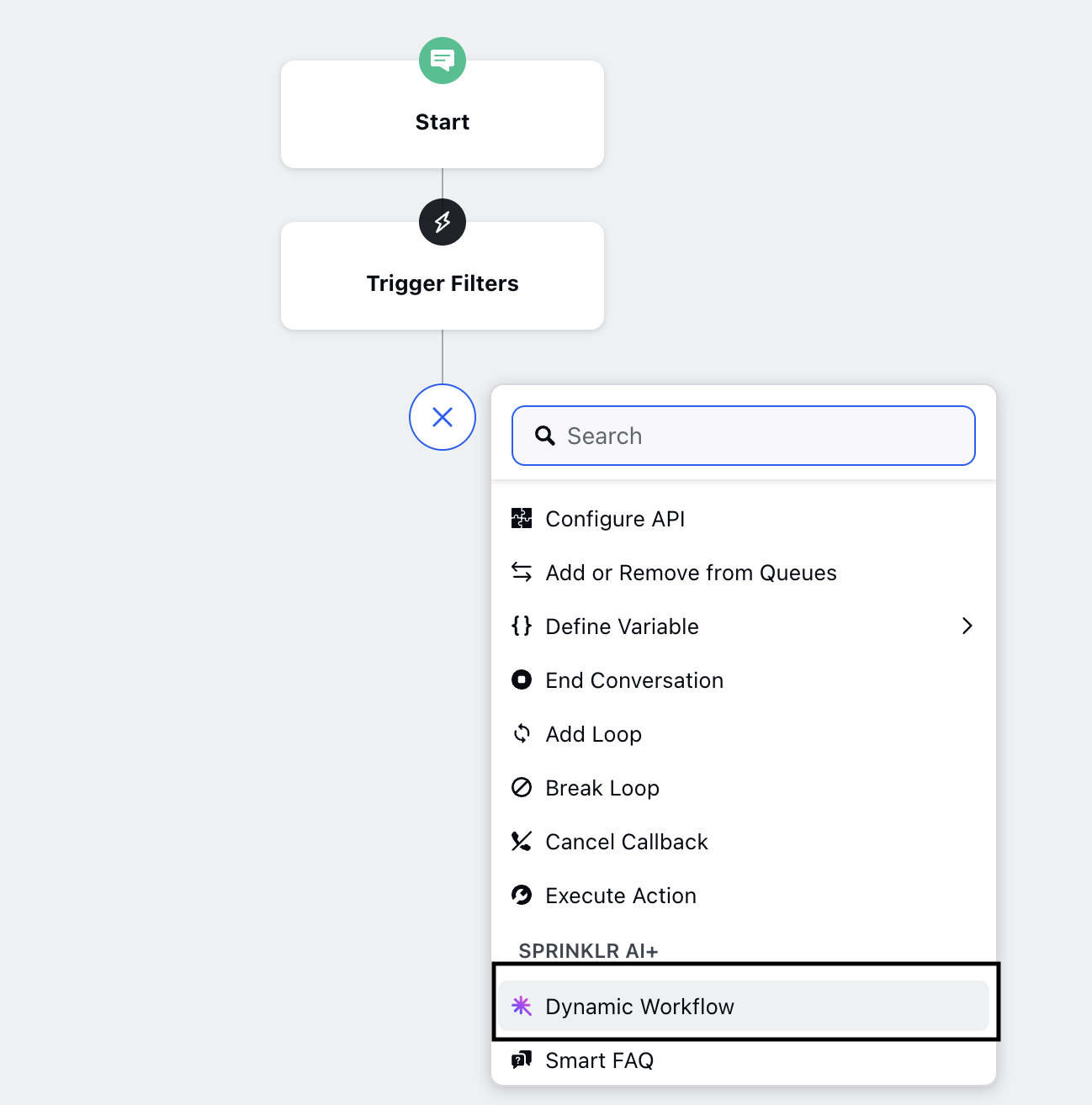Dynamic Workflow node for Voicebot
Updated
Note: This node is part of Sprinklr AI+. Enable this node by raising a support ticket at tickets@sprinklr.com.
Overview
The Dynamic Workflow Node(DWD) is a component in a chatbot's dialogue tree, designed to enhance the chatbot's conversational capabilities and create more human-like interactions. This GPT-powered node efficiently bifurcates intents/entities, collects customer inputs, and processes data to generate responses within a single dialogue tree, eliminating the need for multiple trees with different bot replies.
Configure the Dynamic Workflow Node
To configure the dynamic workflow node, follow the below steps :
Click the Addition icon within your dialogue tree and select Dynamic Workflow.


Enter a Name for the node according to the use case.
Define the Workflow Goal in the pop-up window to outline your use case. The workflow goal serves as guidelines for Gen AI to achieve the desired outcome for your bot. You can specify the information to be captured by the bot and incorporate variables and custom fields using the resource picker to create a dynamic workflow. Additionally, you can utilize Sprinklr AI+ to generate a workflow goal.
Best Practices & Tips for creating Dynamic Workflow Nodes |
|
Next, include the user inputs necessary for the bot . The below table explains the input name , descropion and guidelines around inputs values .

Input Name | Description |
Display Name | This name is used by Sprinklr AI+ to understand the meaining of the variable and the kind of data it will store. Ensure that the Display Name is intuitive for GPT to understand. For example, if the bot is assisting with |
Variable | This variable is created within the Dialogue Tree to store the collected information and to be used later in the
|
Format | This field helps Sprinklr AI+ understand the format in which data needs to be stored. For instance, if you need a PNR |
Required(Checkbox) | This helps Sprinklr AI+ understand whether this is a mandatory or a non-mandatory field. The Dynamic Workflow node will not exit successfully unless it has all the mandatory inputs. (Note: The bot will exit with an |
Previous Message History Length | This helps Sprinklr AI+ gather context on the conversation that happened prior to its invocation. You can use this |
Functions required for Skill | This helps Sprinklr AI+ carry out actions (Example:Calling an API, Sending a Text etc) amidst conversation. Functions required by the node can be configured on the ConvAI app and referenced here. These functions can then be referenced in the prompt dynamically |
Click Save to save the node.
Note: Raise a support ticket to request changes to the backend prompts and ensure that the
chatbot's interactions align with your branding, messaging, and user experience
objectives
Additional Functions
There are specific hardcoded functions which are triggered based on Bot Replies published by the dynamic workflows. They can be used to manage its behavior during user interaction. These include :
BOT_COMPLETED: Whenever the Dynamic Workflow node tries to publish this exacttext, it is blocked by our backend functions and the bot workflow exits successfully from this node. This can be helpful to exit the node whenever a certain set of conditions are met during the bot conversation. It can also be used to create or assign values to local variables upon exit by defining it in a JSON format.
For example: You want to collect 6-digit PNR from the user. In the case where the user does not want to talk to a bot and wants to continue with an agent, the Dynamic Workflow node will be confused and not know how to proceed with the request. Here, we can direct the node in the prompt itself, “Whenever user asks for an agent, reply “BOT_COMPLETED {“agent_flag”:true}”. This command will help the node successfully exit the node, setting the variables as instructed in the JSON.
BOT_ABORT: Similarly, the node can reply with "BOT_ABORT" in situations where the conversation abruptly ends due to specific conditions or errors detected during the interaction. For example, if the user's input is unclear or invalid, you can set up the bot to abort and exit the dynamic workflow node. The DYNAMIC_CHAT_ERROR is a backend system variable that is automatically set to true whenever the bot unexpectedly aborts.
Choosing AI+ version

While designing your bot, you can select the AI model it needs to be built on. Follow the below steps to select your desired AI model -
Under Miscellaneous Settings of ConvAI App, select Additional Settings.
Select the “AI Version” option . This lets you select the AI version that is utilised by your DWD Node and allows for managing custom branches, and use-case based complexity abstraction.